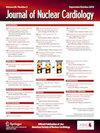低剂量心肌灌注成像在现实世界中的诊断准确性。
IF 3
4区 医学
Q2 CARDIAC & CARDIOVASCULAR SYSTEMS
引用次数: 0
摘要
背景:本大规模研究分析了现实生活中影响低剂量心肌灌注成像诊断准确性的因素及其与冠状动脉造影的相关性。方法:我们比较了常规报告中的数据:(i)低剂量[99mTc]sestamibi应力- mpi,没有衰减校正,主要是运动应激测试;(ii)相应的冠状动脉造影。结果:我们考虑了11位医生报告的1070对冠状动脉造影/压力- mpi结果。平均MPI有效剂量为4.5±2.1 mSv。mpi缺血程度预测> -70%,但不能预测50-70%的冠状动脉狭窄。对于> 70%狭窄的检测,阳性检测的敏感性为74.7%(413/553),特异性为53.2%(275/517)。左束分支阻滞或起搏器(LBBB/PM)患者的阳性预测值较低(45.6% vs. 64.7%, p=0.006),而mpi缺血≥3段或伴有st段抑制的患者的阳性预测值(75.0%(165/220))明显高于mpi缺血< 3段、mpi梗死或孤立性st段抑制的患者(57%(248.0/435))。低剂量应激- mpi的常规结果,主要与运动应激试验相关且未校正衰减,与真实冠状动脉造影结果相关。然而,这种相关性低于传统研究设计,并受到显著CAD和背景变量(LBBB/PM, CAD历史,性别和年龄)定义的影响。更好地考虑这些相互作用的因素可以改善患者的监测。本文章由计算机程序翻译,如有差异,请以英文原文为准。

Diagnostic accuracy of low-dose myocardial perfusion imaging in a real-world setting
Background
This large-scale study analyzes factors affecting the diagnostic accuracy of low-dose myocardial perfusion imaging and correlation with coronary angiography in a real-world practice.
Methods
We compared data extracted from routine reports of (i) low-dose [99mTc]sestamibi stress-MPI performed with no attenuation correction and predominantly exercise stress testing and (ii) the corresponding coronary angiography.
Results
We considered 1070 pairs of coronary angiography/stress-MPI results reported by 11 physicians. Mean MPI effective dose was 4.5 ± 2.1 mSv. The extent of MPI-ischemia was predictive of >70% but not 50%–70% coronary stenoses. A positive test was associated with a sensitivity of 74.7% (413/553) and a specificity of 53.2% (275/517) for >70% stenosis detection. Positive predictive values were lower in patients with left bundle branch block or pacemakers (LBBB/PM) (45.6% vs 64.7%, P = .006) and markedly higher for patients with MPI-ischemia ≥3 segments or associated with ST-segment depression (75.0% (165/220)) as compared to those with <3 segments MPI-ischemia, MPI-infarction or isolated ST-segment depression (57% (248.0/435), P < .001). Negative predictive values were lower for patients with previous coronary artery disease (CAD) history (58.3%), male (61.0%), and elderly patients (59.6%) (vs 72.1%, 79.2%, and 72.4%, respectively, all P < .05).
Conclusions
Routine results from low-dose stress-MPI, predominantly associated with exercise stress testing and uncorrected for attenuation, correlate with real-world coronary angiography results. However, this correlation is lower than that achieved with conventional study designs and affected by the definition of significant CAD and context variables (LBBB/PM, CAD history, sex, and age). Better consideration of these interacting factors could improve patient monitoring.
求助全文
通过发布文献求助,成功后即可免费获取论文全文。
去求助
来源期刊
CiteScore
5.30
自引率
20.80%
发文量
249
审稿时长
4-8 weeks
期刊介绍:
Journal of Nuclear Cardiology is the only journal in the world devoted to this dynamic and growing subspecialty. Physicians and technologists value the Journal not only for its peer-reviewed articles, but also for its timely discussions about the current and future role of nuclear cardiology. Original articles address all aspects of nuclear cardiology, including interpretation, diagnosis, imaging equipment, and use of radiopharmaceuticals. As the official publication of the American Society of Nuclear Cardiology, the Journal also brings readers the latest information emerging from the Society''s task forces and publishes guidelines and position papers as they are adopted.

 求助内容:
求助内容: 应助结果提醒方式:
应助结果提醒方式:


